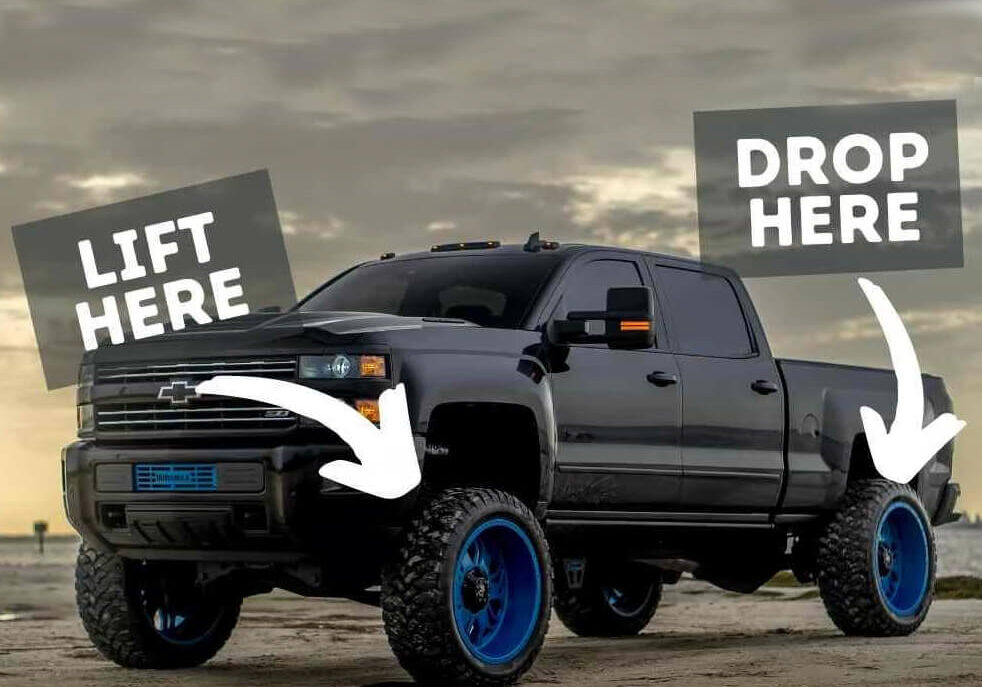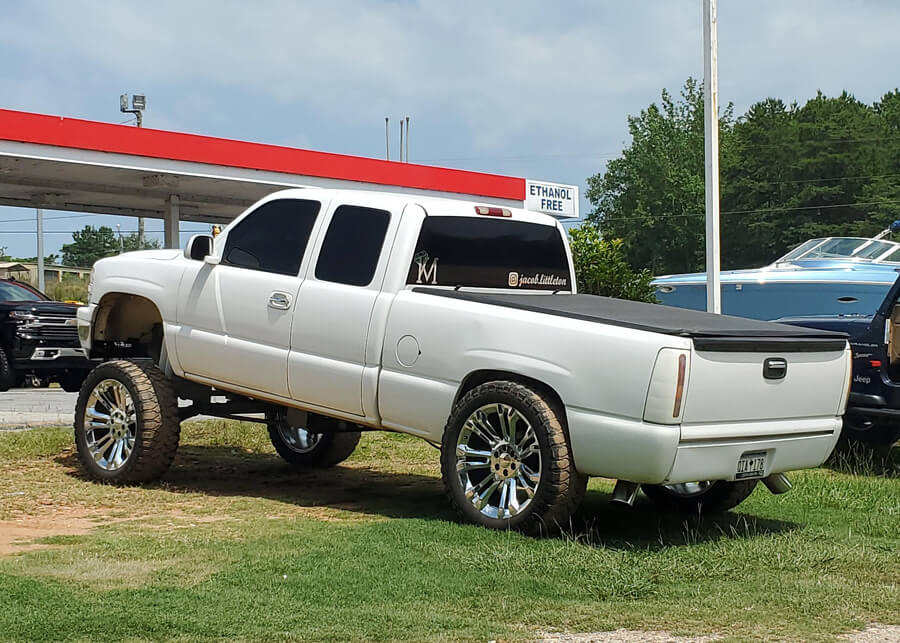Carolina Squat: Everything You Need To Know About Squatted Trucks
What is a Carolina Squat? Where did it come from? And is it even legal? Here is everything you need to know about squatted trucks.
Updated: March 7, 2024 // Car Culture, Trucks

Home // Car Culture //
What Is a Squatted Truck?
Truck squatting is a controversial truck trend that has been making people look twice and starting arguments among truck guys for years. The Carolina Squat is a truck mod technique that involves lowering the rear of a vehicle to give it an aggressive stance, also known as the "Cali Lean" or "Tennessee Tilt." This is a favorite mod of Southern pickup and SUV owners.
Common Vehicles That Carolina Squat
- Trucks: Full-size trucks like Ford F-150s, Chevrolet Silverados, and Dodge Rams are popular choices for this modification.
- SUVs: Large SUVs like Chevrolet Tahoes, GMC Yukons, and Cadillac Escalades have also been modified with squats.
- Rarely, sedans: Some sedan owners have attempted Carolina Squats on cars like Honda Civics or Toyota Camrys.
Carolina Squat Vs. California Lean: What's The Difference?
Now, let's hop over to the land of sunshine and beaches – California. Over there, they've got their own version of the squatted truck, known as the California Lean or CenCal (short for central California). While the Carolina Squat steals the show with its exaggerated stance, the California styles take a more subtle approach, drawing inspiration from off-road racing.
California, which is close to the Pacific Ocean, is where the CenCal, Cali Lean, and Baja-Stance styles got their start. These styles all have a reverse rake. Some races in Southern California, like the Baja 500 and Baja 1,000, have an effect on these styles. In these races, the front runners have soft multi-link or leaf-sprung rear suspension, which makes their trucks nose-high. These trucks usually sit a little lower in the back than Carolina Squat trucks because of front lifts and rear lowering kits. Carolina Squat trucks sit nose-high for style.
Carolina Squat: Originating from the southeastern United States, particularly in North and South Carolina, this modification involves lifting the rear of the truck while keeping the front end low. It's often associated with a more exaggerated tilt, giving the truck a distinctive "nose-down" appearance.
California Lean: On the other hand, the California Lean is more prevalent on the West Coast, where enthusiasts opt for a subtler tilt. The rear end is slightly elevated, creating a sleek and aerodynamic profile without the dramatic stance of its Carolina counterpart.

Who Started Carolina Squat?
The Carolina Squat, also known as the "Cali Lean" or "Tennessee Tilt," originated in the early 2000s among car enthusiasts in North and South Carolina. Truck owners wanted to give their ride a unique, aggressive stance that set them apart from others on the road, and the Carolina Squat quickly gained popularity. While it's unclear who started this trend, many believe it was inspired by off-road racing trucks used in events like SCORE International Off-Road Racing Series. The Carolina Squat mimics the high front end of these race trucks.
Squatting is done primarily to look good and show off rather than improved off-road capabilities.
How to Squat Your Truck?
Want to give your ride a unique look? Learn how to perform a Carolina Squat with these simple steps.
Gather the Necessary Tools and Materials
- Adjustable coil overs or airbag suspension kit specific to your vehicle make and model
- Cutting tools (like an angle grinder)
- Welding equipment
- Safety gear (gloves, goggles, etc.)
- Floor jack and jack stands for safely lifting the vehicle off the ground
Step-by-Step Guide to Performing a Carolina Squat
- Choose the right suspension components: Get adjustable coilovers or lowering springs for the front and lift blocks or add-a-leaf kits for the rear of your truck.
- Prepare your tools: Gather all necessary tools like wrenches, sockets, jack stands, hydraulic jacks, and wheel chocks before starting any work on your vehicle.
- Raise and secure your truck: Safely raise both ends of your vehicle using hydraulic jacks and place them securely on jack stands. Ensure that wheel chocks are in place behind each tire for added safety.
- Install front suspension modifications: Remove existing shocks or struts and replace them with new adjustable coilovers or lowering springs according to manufacturer instructions. Check out this instructional video for proper installation techniques.
- Lift rear end of truck: Add lift blocks under leaf springs or install add-a-leaf kits between existing leaf spring layers per product guidelines provided by manufacturers. Check out this detailed guide for more information.
- Reinstall wheels and lower truck: Once all suspension modifications are complete, reinstall the wheels and carefully lower your vehicle back onto the ground. Make sure to torque lug nuts according to manufacturer specifications.
- Perform alignment check: Have a professional perform an alignment check on your truck to ensure proper handling and prevent uneven tire wear.
For an expert opinion, consult a professional mechanic or visit a custom car modification shop. For more information on how to perform other popular car mods, check out our guide on Popular Car Modifications.
Related: Video: Ram Rampage Prototype Spotted Without Camo in South America
Is A Squatted Truck Legal?
The legality of a squatted truck varies by state, so check local laws before attempting this modification. In some areas, suspension modifications are regulated by specific height restrictions or limits on how much the vehicle's original suspension can be altered. For example, in North Carolina, lawmakers have passed House Bill 692, which prohibits vehicles from having a front-end elevation that exceeds four inches above the rear-end elevation.
- Check Local Laws: Always consult your local DMV for information about suspension modification regulations in your area.
- Contact Professionals: Reach out to experienced mechanics or automotive shops for guidance on legal squatting methods and alternatives that comply with local laws.
- Safety Inspections: After completing any significant modification like a Carolina Squat, ensure you pass any required safety inspections mandated by your state.
Aside from legal concerns, it's essential to consider the potential dangers associated with performing a Carolina Squat. Incorrectly done squats can cause harm to the structure and raise the center of gravity, which could make it more likely for a rollover incident. Additionally, altering your truck's suspension may also affect its handling capabilities and braking performance, potentially putting you and other road users at risk.
The People Vs. Carolina Squat
Looks like the law isn't too fond of squatted trucks either. Two states, North Carolina and Virginia, have already put the kibosh on the Carolina Squat, citing safety concerns. And now, Southern Carolina is following suit with SB363 on the horizon. It's clear that lawmakers aren't messing around when it comes to keeping the roads safe.
Related: Car Companies That Were Killed Off in the 21st Century
What Are the Dangers of Driving a Squatted Truck?
Sure, squatted trucks might turn heads on the road, but they also come with a hefty dose of danger. Imagine trying to see over the hood of your truck when it's pointing towards the sky – not exactly a recipe for safe driving, right? And let's not forget about the poor folks driving behind you; those headlights are probably blinding them!
Latest Squatted Truck News
But hey, the squatted truck community isn't going down without a fight. Some folks are worried that these bans are just the beginning, but who knows? Maybe there's a compromise on the horizon. Until then, we'll be keeping an eye on any new laws that come our way.
Questions About The Carolina Squat
The Carolina Squat was banned due to safety concerns, as the uneven weight distribution can cause structural damage, increase the center of gravity, and make trucks more prone to rollover accidents.
In many states, performing a full-blown Carolina Squat on your truck is illegal due to safety hazards it poses, but laws may vary by state, so it's important to check local regulations before making any modifications.
In 2023, the new law became a reality. The front or back bumper of a "squatted" car is at least 4 inches higher than the other bumper. People who support the new law say that the change makes it harder for drivers to see through their windshield and could make it harder for them to see people or smaller cars.
Laws banning or restricting squatted trucks began appearing in various US states around 2018-2023. North Carolina officially made it illegal in December 2023 with House Bill 692, which prohibits alterations causing a difference in height greater than three inches between front and rear bumpers.
Disclaimer: The writers of this article may have used artificial intelligence to help them with some of the material. It should not be a replacement for professional help.
Sources:
- Gilboy, J. (2022, March 21). The ‘Carolina Squat’ Truck Trend Is Outlawed in Virginia Now, Too. The Drive. https://www.thedrive.com/news/44861/the-carolina-squat-truck-trend-is-outlawed-in-virginia-now-too
- Moscuzza, M. (2023, February 22). Is the “Carolina Squat” an Illegal Car Modification? Is The “Carolina Squat” an Illegal Car Modification? https://www.motorbiscuit.com/carolina-squat-illegal-car-modification/
- Morgan Aero SuperSports. (2011, January 4). Morgan Aero SuperSports Review. https://www.caranddriver.com/reviews/a15124254/morgan-aero-supersports-morgan-aero-review/
- J.D. Power. (n.d.). What Is The Carolina Squat? Retrieved May 31, 2023, from https://www.jdpower.com/cars/shopping-guides/what-is-the-carolina-squat
- Chappell, B. (2021, December 3). The “Carolina Squat” is now illegal on North Carolina’s roads. NPR. https://www.npr.org/2021/12/03/1061200749/carolina-squat-squatted-trucks-suvs-illegal-north-carolina







